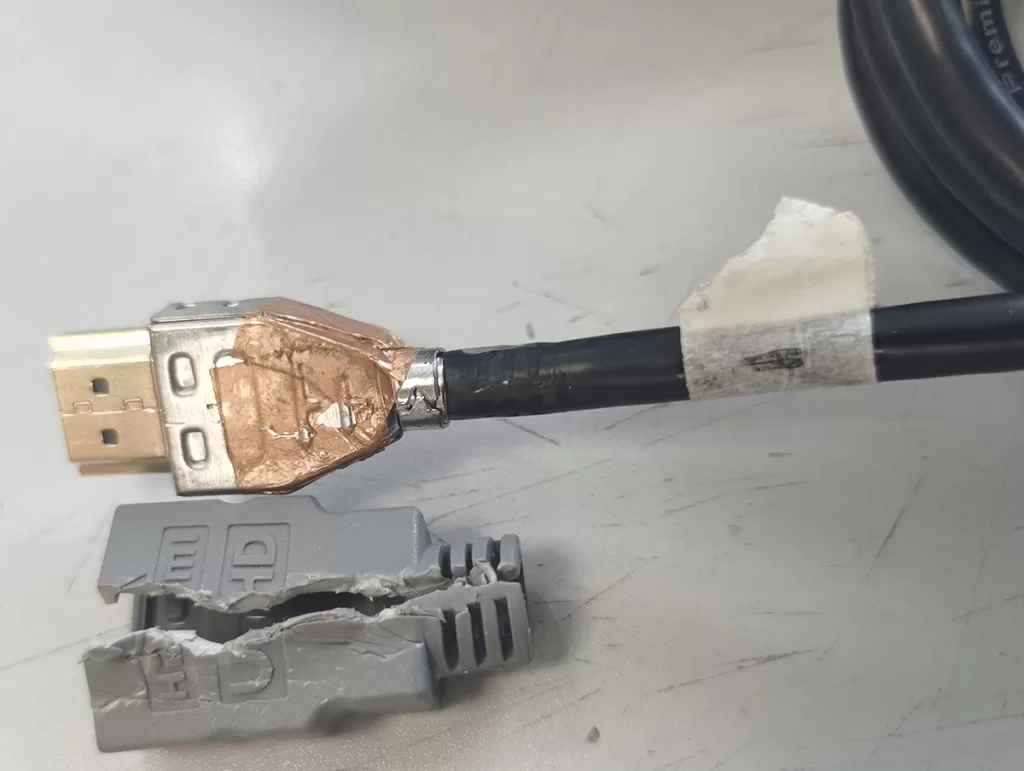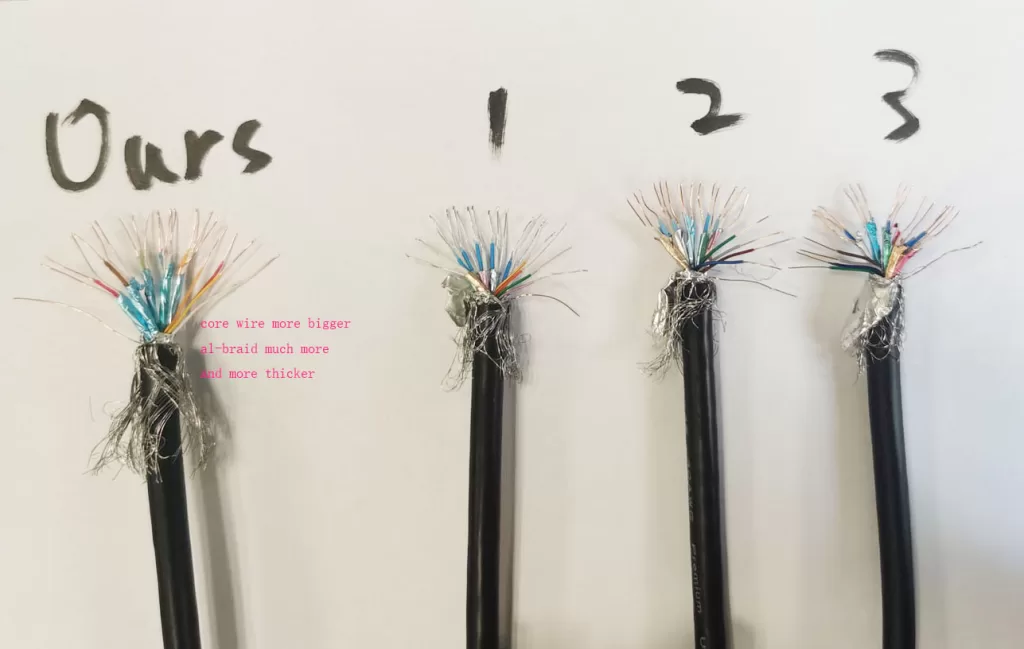1. Introduction to HDMI Cables in Data Centers
While HDMI (High-Definition Multimedia Interface) cables are primarily associated with consumer electronics and home entertainment systems, they have found their way into data center environments as well. As data centers evolve to support not only traditional IT workloads but also multimedia applications, high-resolution video streaming, and advanced visualization technologies, the need for reliable and high-performance connectivity solutions like HDMI cables has become increasingly important.

2.The Evolution of Data Centers and Multimedia Demands
2.1. Traditional Data Center Workloads Historically
Data centers have been designed to support enterprise applications, databases, web services, and other traditional IT workloads. These workloads primarily relied on Ethernet networks for data transmission and did not have significant multimedia or video requirements.
2.2. Emergence of Multimedia-Intensive Applications
However, in recent years, the landscape of data center workloads has undergone a significant transformation. The rise of multimedia-intensive applications, such as video conferencing, digital signage, surveillance systems, and media streaming services, has created new demands for high-quality audio and video transmission within data center environments.
2.3. Adoption of Advanced Visualization Technologies
Additionally, the adoption of advanced visualization technologies, such as virtual reality (VR), augmented reality (AR), and high-resolution displays, has further fueled the need for high-bandwidth and low-latency connectivity solutions. Data centers now support a wide range of applications that require real-time rendering, immersive experiences, and seamless multimedia integration.
3.HDMI Cables in Data Center Environments
3.1. Use Cases and Applications
HDMI cables find application in various scenarios within data center environments, including:
a. Video Streaming and Digital Signage: Data centers often host video streaming platforms and digital signage systems that require high-definition video and audio transmission. HDMI cables provide a reliable and cost-effective solution for connecting media servers, encoders, and displays within these environments.
b. Virtual Desktop Infrastructure (VDI) and Remote Workstations: In VDI deployments, where desktop environments are centralized and hosted in the data center, HDMI cables can be used to connect thin clients or zero clients to high-resolution displays, enabling users to access their virtual desktops with rich multimedia experiences.
c. Command and Control Centers: Many organizations, such as government agencies, military installations, and security operations centers, rely on command and control centers within data centers. These facilities often feature large video walls or multi-display setups, where HDMI cables are used to interconnect workstations, video processors, and display devices.
d. Multimedia Rendering and Visualization: Data centers supporting applications in fields like animation, 3D modeling, scientific visualization, and media production often require high-resolution displays and multimedia connectivity. HDMI cables can be used to connect workstations, rendering nodes, and display devices within these specialized environments.
3.2. Advantages of HDMI Cables in Data Centers
HDMI cables offer several advantages that make them suitable for data center applications:
a. High-Definition Video and Audio Support: HDMI cables can transmit uncompressed digital video and audio signals, allowing for high-quality multimedia experiences without signal degradation.
b. Bandwidth and Resolution Support: Modern HDMI specifications provide ample bandwidth to support high resolutions up to 8K, as well as features like High Dynamic Range (HDR) and high refresh rates, which are essential for advanced visualization applications.
c. Long Cable Lengths: While standard HDMI cables have a maximum recommended length of around 15 meters, active HDMI cables and fiber optic HDMI cables can extend the transmission distance up to 100 meters or more, enabling flexible connectivity within data center racks and across longer distances.


d. Audio Support and Synchronization: HDMI cables can transmit multichannel audio along with video, enabling synchronized audio and video experiences, which is crucial for applications like video conferencing and multimedia presentations.
e. Plug-and-Play Connectivity: HDMI cables offer a simple and standardized plug-and-play connectivity solution, reducing the complexity of installations and ensuring compatibility between various devices and displays.
4.Challenges and Considerations
4.1. Cable Length Limitations
While HDMI cables can support longer distances through the use of active or fiber optic cables, there are still practical limitations on cable lengths within data center environments. Proper cable management and planning are necessary to ensure signal integrity and minimize potential signal degradation over long cable runs.
4.2. Electromagnetic Interference (EMI) and Shielding
Data centers are often densely packed with electronic equipment, which can generate significant electromagnetic interference (EMI). HDMI cables must be properly shielded and installed to minimize the risk of signal interference and ensure reliable multimedia transmission.
In order to achieve strict and stable EMI performance requirements, our factory in the production of HDMI cable, the use of full-clad metal connectors and then wrapped with a layer of copper foil, aluminum mesh braided shielding layer using more than 128 aluminum mesh, through the HDMI 1.4/2.0/2.1 test and fish-eye test (TDR).
Some HDMI cables have been tested in the data center for over 4 years, necessitating strict stability.


4.3. Bandwidth and Resolution Scaling
As data center applications continue to evolve and demand higher resolutions and refresh rates, the bandwidth requirements for HDMI cables will also increase. Ensuring that the HDMI cables and infrastructure can support future scaling and higher bandwidth demands is crucial for long-term compatibility and performance.
4.4. Security and Content Protection
In certain data center applications, such as command and control centers or secure multimedia environments, content protection and security may be a concern. HDMI cables and devices must adhere to relevant security standards and support content protection mechanisms like High-bandwidth Digital Content Protection (HDCP) to prevent unauthorized access or copying of sensitive multimedia content.
4.5. Integration with Existing Infrastructure
Integrating HDMI cables and multimedia connectivity solutions into existing data center infrastructure can be a challenge, particularly in legacy environments. Careful planning, compatibility testing, and potential upgrades to existing cabling and equipment may be necessary to ensure seamless integration and optimal performance.
5.HDMI Cable Specifications and Variants
5.1. Standard HDMI Cables
Standard HDMI cables are commonly used for shorter distances and consumer-grade applications. They support resolutions up to 4K (3840 x 2160) and can transmit uncompressed video and audio signals over a single cable.
5.2. High-Speed HDMI Cables
High-Speed HDMI cables are designed to support higher resolutions, such as 4K and 8K, as well as higher refresh rates and advanced features like HDR. These cables are often used in professional and commercial applications, including data center environments.
5.3. Active HDMI Cables
Active HDMI cables incorporate signal boosters or repeaters, allowing for longer cable lengths without significant signal degradation. These cables are suitable for data center applications where longer cable runs are required, typically up to 25 meters or more.

5.4. Fiber Optic HDMI Cables
Fiber optic HDMI cables use fiber optic technology to transmit HDMI signals over longer distances, typically up to 100 meters or more. These cables are immune to electromagnetic interference and offer higher bandwidth capabilities, making them ideal for data center environments with stringent distance and performance requirements.
5.5. HDMI over Ethernet/IP Solutions
In some data center scenarios, HDMI signals can be transmitted over existing Ethernet or IP networks using specialized HDMI over Ethernet/IP extenders or converters. These solutions can provide flexible and scalable multimedia connectivity while leveraging existing network infrastructure.
6.Deployment Considerations and Best Practices
6.1. Cable Management and Routing
Proper cable management and routing are essential in data center environments to ensure signal integrity, minimize interference, and maintain a organized and efficient infrastructure. HDMI cables should be routed and secured appropriately, avoiding sharp bends or excessive tension that could damage the cables or impact signal quality.
6.2. Labeling and Documentation
Comprehensive labeling and documentation of HDMI cable installations are crucial for efficient maintenance, troubleshooting, and future upgrades. Clear labeling and documentation can help data center personnel quickly identify and locate specific cable runs, connections, and associated equipment.
6.3. Redundancy and Failover
In mission-critical data center applications, such as command and control centers or high-availability multimedia environments, redundancy and failover measures should be implemented for HDMI cable connections. This can include redundant cable runs, automatic failover mechanisms, or hot-swappable components to ensure uninterrupted multimedia transmission.
6.4. Power and Cooling Considerations
HDMI cables and associated equipment, such as signal boosters or converters, may require additional power and cooling considerations within data center racks or enclosures. Proper power distribution and cooling strategies should be implemented to ensure reliable operation and prevent overheating or power-related issues.
6.5. Testing and Certification
Regular testing and certification of HDMI cable installations are recommended to ensure compliance with relevant standards, identify potential signal degradation or interference issues, and verify the overall performance and reliability of the multimedia connectivity solution.
7.Future Trends and Emerging Technologies
7.1. Higher Resolutions and Bandwidths
As display technologies continue to advance, the demand for higher resolutions and higher bandwidths will increase in data center environments. The upcoming HDMI 2.1 specification supports resolutions up to 10K (10,240 x 4,320) and higher refresh rates, enabling more immersive and detailed multimedia experiences. Data centers will need to adopt HDMI cables and infrastructure that can accommodate these higher bandwidth requirements.
7.2. HDMI 2.1 and Enhanced Features
In addition to supporting higher resolutions and bandwidths, the HDMI 2.1 specification introduces several enhanced features that could be beneficial in data center applications:
a. Enhanced Audio Return Channel (eARC): Allows for higher-quality audio transmission from displays back to audio systems, enabling advanced audio setups and configurations in multimedia environments.
b. Dynamic HDR: Enables dynamic metadata exchange between devices and displays, allowing for enhanced High Dynamic Range (HDR) experiences and improved color accuracy.
c. Auto Low Latency Mode (ALLM): Automatically reduces input latency for gaming and interactive applications, which could be useful in data center environments supporting virtual reality (VR) or augmented reality (AR) applications.
d. Quick Frame Transport (QFT): Reduces latency and improves responsiveness for interactive applications, enhancing the user experience in multimedia environments.
7.3. HDMI Alternative Mode for USB Type-C
The HDMI Alternative Mode for USB Type-C is an emerging technology that allows HDMI signals to be transmitted over USB Type-C connections. This could simplify cabling and connectivity in data centers, as USB Type-C becomes more prevalent in computing devices and peripherals. However, it also introduces potential compatibility and interoperability challenges that will need to be addressed.
7.4. HDMI Over IP and Software-Defined Video Distribution
HDMI Over IP solutions, which transmit HDMI signals over standard IP networks, are gaining traction in various industries, including data centers. These solutions can leverage existing network infrastructure and provide flexible and scalable multimedia distribution. Additionally, the concept of software-defined video distribution, where multimedia content is managed and distributed through software-based platforms, could further enhance the capabilities of HDMI in data center environments.
7.5. Wireless HDMI and Multimedia Transmission
While wired HDMI connections remain the primary choice for data center applications, the development of wireless HDMI and multimedia transmission technologies could introduce new possibilities. Wireless solutions could reduce cabling complexity and provide more flexibility in multimedia distribution, particularly in temporary or rapidly changing data center environments. However, concerns around bandwidth limitations, latency, and interference will need to be addressed before widespread adoption.
7.6. Integration with Artificial Intelligence (AI) and Machine Learning (ML)
As artificial intelligence (AI) and machine learning (ML) technologies continue to advance, their integration with multimedia and visualization applications in data centers will become more prominent. HDMI cables and connectivity solutions may need to support specialized AI accelerators, high-performance computing (HPC) systems, and advanced data processing capabilities to enable real-time rendering, analysis, and visualization of complex data sets.
8.Real-World Case Studies and Deployments
8.1. Command and Control Center for Military Operations
In a military command and control center, HDMI cables and multimedia connectivity solutions play a crucial role in facilitating real-time situational awareness and decision-making. Multiple high-resolution displays, video walls, and multimedia workstations are interconnected using HDMI cables, enabling the seamless integration and visualization of various data sources, such as satellite imagery, sensor data, and intelligence feeds.
8.2. Virtual Reality (VR) Rendering and Visualization Cluster
In a data center supporting virtual reality (VR) applications, a cluster of high-performance rendering nodes is interconnected using HDMI cables to generate and distribute immersive VR content. HDMI cables transmit the rendered VR scenes to specialized VR headsets or display systems, enabling users to experience highly detailed and interactive virtual environments in real-time.
8.3. Media Production and Post-Production Facility
In a data center hosting media production and post-production workflows, HDMI cables are extensively used to connect high-resolution displays, video editing workstations, color grading systems, and media storage servers. The ability to transmit uncompressed, high-quality video and audio signals over HDMI cables is essential for ensuring accurate color reproduction, detailed visual inspection, and seamless integration of various production tools and systems.
8.4. Digital Signage and Video Streaming Platform
In a data center hosting a large-scale digital signage or video streaming platform, HDMI cables are used to connect media servers, encoders, and displays throughout the facility. HDMI cables enable the reliable distribution of high-definition video and audio content to various digital signage endpoints or streaming clients, ensuring a consistent and high-quality viewing experience for end-users.
8.5. Scientific Visualization and Data Analysis Center
In a data center dedicated to scientific visualization and data analysis, HDMI cables connect high-performance computing (HPC) clusters, visualization workstations, and large-scale display systems. These interconnected systems enable researchers and scientists to visualize and analyze complex data sets, such as simulations, medical imaging, or geospatial data, in stunning detail and clarity.
9.Industry Standards and Certifications
9.1. HDMI Licensing and Certification
The HDMI standard is governed by the HDMI Licensing Administrator, Inc. (HDMI LA), which oversees the licensing and certification of HDMI products. HDMI cables and devices used in data center environments must comply with the relevant HDMI specifications and obtain the necessary certifications to ensure interoperability, performance, and adherence to industry standards.
9.2. HDCP and Content Protection
In certain data center applications, content protection and security are critical concerns. The High-bandwidth Digital Content Protection (HDCP) standard is designed to prevent unauthorized copying and redistribution of protected digital content transmitted over HDMI connections. HDMI cables and devices used in data centers handling sensitive or copyrighted multimedia content must support HDCP to ensure compliance with content protection regulations.
9.3. Electromagnetic Compatibility (EMC) and Shielding
Due to the high density of electronic equipment and potential electromagnetic interference (EMI) in data center environments, HDMI cables and associated equipment must meet stringent electromagnetic compatibility (EMC) standards. Proper shielding and EMC certification ensure reliable operation and minimize the risk of interference or signal degradation.
9.4. Safety and Regulatory Compliance
HDMI cables and related equipment used in data centers must comply with relevant safety standards and regulatory requirements, such as those set by organizations like Underwriters Laboratories (UL), the International Electrotechnical Commission (IEC), and the European Union (CE marking). These standards and regulations ensure the safe and proper installation and operation of HDMI components in data center environments.
9.5. Industry Associations and Consortia
Several industry associations and consortia play a role in promoting and advancing HDMI standards and technologies, including the HDMI Forum, the Video Electronics Standards Association (VESA), and the Society of Motion Picture and Television Engineers (SMPTE). Participation in these organizations and adherence to their guidelines can help data center operators and equipment manufacturers stay up-to-date with the latest developments and best practices related to HDMI and multimedia connectivity.
10.Conclusion and Future Outlook
The application of HDMI cables in data center environments is a testament to the evolving nature of these facilities and the increasing demand for high-quality multimedia experiences. As data centers continue to support a diverse range of workloads, including multimedia-intensive applications, advanced visualization technologies, and immersive experiences, the need for reliable and high-performance connectivity solutions like HDMI cables will only grow.
While HDMI cables offer numerous advantages for data center multimedia connectivity, such as high-definition video and audio support, bandwidth and resolution capabilities, and plug-and-play connectivity, they also present challenges related to cable length limitations, electromagnetic interference, and integration with existing infrastructure.
To address these challenges and meet the ever-increasing demands of data center multimedia applications, ongoing advancements in HDMI technology, such as the introduction of HDMI 2.1 and higher bandwidth capabilities, fiber optic and active HDMI cables, and emerging technologies like HDMI over IP and wireless HDMI solutions, will play a crucial role.
As data centers continue to evolve and integrate with emerging technologies like artificial intelligence (AI), machine learning (ML), and advanced data processing capabilities, the role of HDMI cables and multimedia connectivity solutions will become even more critical in enabling real-time rendering, analysis, and visualization of complex data sets.
Looking ahead, the future of HDMI cables in data centers will be shaped by ongoing technological advancements, industry standards and certifications, and the ever-growing demand for immersive and high-quality multimedia experiences across various industries and applications.
